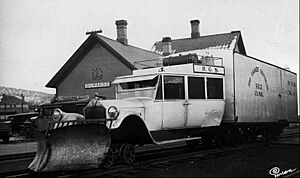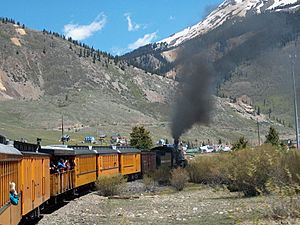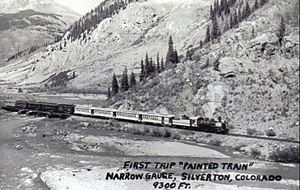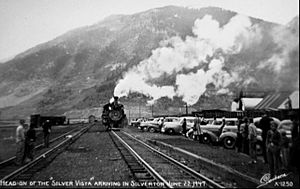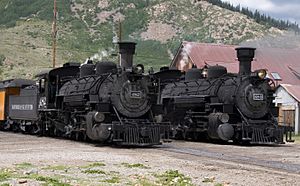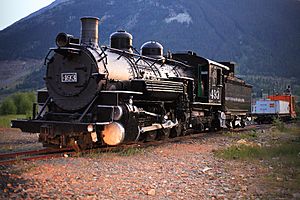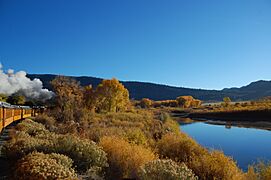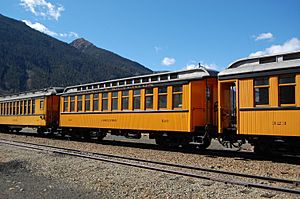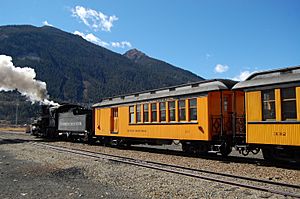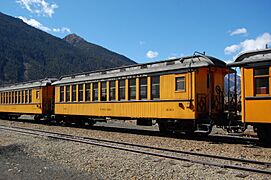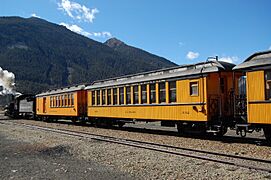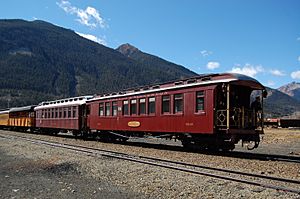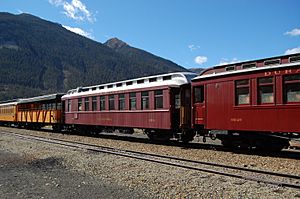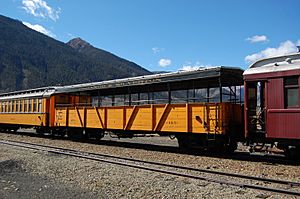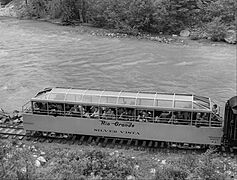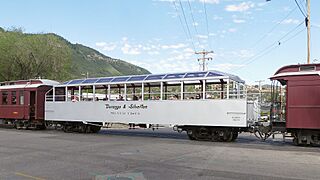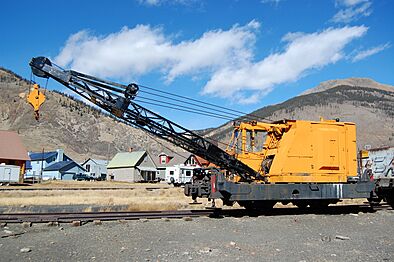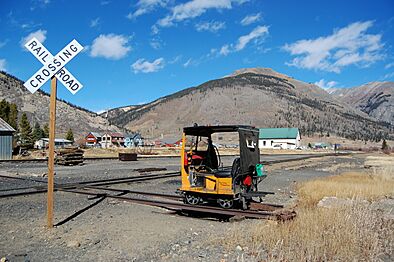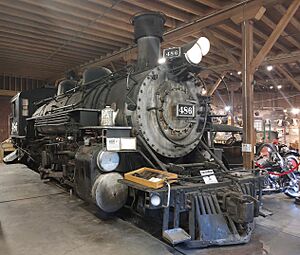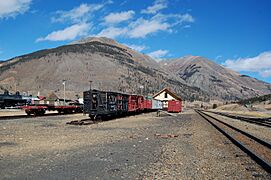Durango and Silverton Narrow Gauge Railroad facts for kids
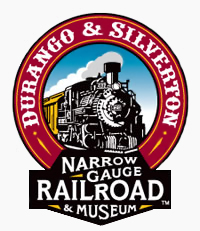 |
|
| Overview | |
|---|---|
| Headquarters | Durango, Colorado |
| Locale | La Plata County, Colorado San Juan County, Colorado |
| Dates of operation | 1881–present |
| Technical | |
| Track gauge | 3 ft (914 mm) |
| Length | 45 miles (72 km) |
|
Durango and Silverton Narrow Gauge Railroad
|
|
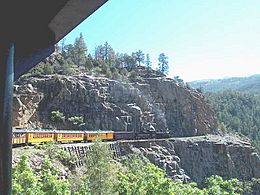
Highline above Animas Canyon
|
|
| Location | Durango, Colorado Silverton, Colorado |
|---|---|
| Built | 1882 |
| Architect | General William J. Palmer |
| NRHP reference No. | 66000247 |
| Significant dates | |
| Added to NRHP | October 15, 1966 |
| Designated NHL | July 4, 1961 |
The Durango and Silverton Narrow Gauge Railroad, often called the D&SNG, is a special train line in Colorado. It uses a narrow track, only 3 feet wide, which is different from most trains. This historic railroad runs for about 45 miles between the towns of Durango and Silverton. It's so important that it's been named a National Historic Landmark.
This railway first opened in 1882. It was built by the Denver and Rio Grande Railroad (D&RG) to carry valuable silver and gold from the San Juan Mountains. The line from Durango to Silverton has been running without stopping since 1881. Today, it's a popular tourist attraction, carrying passengers who want to experience a ride on a historic train. It's one of the few places in the United States where you can still ride a steam locomotive that has been used continuously for so long.
In March 1981, the D&RGW sold this part of the line, and the D&SNG company was created. The D&SNG and the Cumbres and Toltec Scenic Railroad (C&TSRR) are the only parts left of the old D&RGW narrow-gauge system. The D&SNG has many steam locomotives and diesel locomotives. Some of its train cars are even from the 1880s! The trains run from Durango to Cascade Wye in winter and all the way to Silverton in summer. The Durango train station, built in 1882, still looks like it did back then.
Contents
The Railroad's Story
William Jackson Palmer was a general during the American Civil War. After the war, he came to Colorado and planned to build a narrow-gauge railroad. He thought a 3-foot wide track would be perfect for the mountains and cheaper to build. In 1871, his company, the Denver & Rio Grande Railway, started laying tracks.
In July 1881, the D&RG reached Durango. Building the last 45 miles to Silverton took only nine months and five days. Workers, many of them Chinese and Irish immigrants, blasted through canyon cliffs to make space for the tracks. The D&RG reached Silverton on July 10, 1882. The town was named Silverton because a miner said silver could be found there by the ton. Trains immediately started carrying passengers and goods.
Over the years, the railroad faced challenges like economic problems and competition from trucks. Snowslides and floods also made it hard to keep the line running.
The Silverton Train for Tourists
After World War II, more people started traveling for fun. The Silverton branch of the railroad became popular, especially after Hollywood movies were filmed there. On June 24, 1947, the railroad started a special summer-only train service called The Silverton. Later, they painted a locomotive and four cars bright yellow, calling it "The Painted Train." This started a new era of tourism that continues today.
By the 1960s, the railroad wanted to stop running the Silverton line because freight traffic was low. But the government said no, because so many tourists were riding it. So, the railroad had to invest in more train cars and improve the Durango station. As more people rode the train, they even started running a second train to Silverton on busy days.
Changes in the 1970s
By 1971, the Silverton branch and the nearby Cumbres and Toltec Scenic Railroad were the only parts left of the Rio Grande's once huge narrow-gauge system. In the late 1970s, the railroad tried to sell the Silverton branch. In 1979, Charles Bradshaw, a citrus grower from Florida, offered to buy it. On October 5, 1980, The Silverton made its last trip under the old railroad's ownership. This ended an era of narrow-gauge train operations that had begun 110 years earlier.
Recent Years: 2000s to Today
In June 2018, the railroad had to close for several weeks because of a large wildfire called the "416 Fire". This fire burned over 54,000 acres of forest. People thought the railroad's coal-burning steam locomotives might have caused the fire. Because of this risk, the railroad's owner decided to spend millions of dollars to change the steam locomotives from burning coal to burning oil. They also bought two new diesel locomotives.
As of 2023, the railroad is working to convert most of its steam locomotives to run on oil. The railroad also closed for several months in 2020 because of the COVID-19 pandemic.
New Owners and Improvements
Charles Bradshaw Jr. bought the D&RGW's Silverton branch on March 25, 1981. He wanted to improve the railroad and attract more passengers. He brought in experienced managers and new employees.
Many old D&RGW locomotives and train cars that hadn't been used in Durango for years were restored. Larger "K-36" and "K-37" locomotives were fixed up and ran to Silverton for the first time after bridges and tracks were improved. Old train cars from the 1880s were beautifully restored, and new ones were added. For the first time in many years, trains with two locomotives (called "double-headed trains") ran, and more trains were scheduled to handle the growing number of passengers.
The Durango train yard also got big improvements. The old roundhouse, where engines are stored and repaired, was extended. A new car shop was built, and the station was repaired. The number of workers grew, and Durango became an even bigger tourist town. Sadly, the original 1881 Durango roundhouse burned down in 1989. All six working locomotives inside were damaged but could be repaired. A new roundhouse was built in 1990 using bricks from the old one.
In March 1997, Bradshaw sold the D&SNG. Then, in July 1998, it was sold again to American Heritage Railways. This company later moved its main office to Durango, Colorado. The D&SNG now has two museums, one in Durango and one in Silverton.
D&SNG Locomotives
As of April 2024, the Durango and Silverton Narrow Gauge Railroad has nineteen locomotives. Eight are steam locomotives that have been changed to burn oil, and nine are diesel locomotives.
| Number | Image | Type | Wheel arrangement | Classification | Builder | Built | Status | Notes |
|---|---|---|---|---|---|---|---|---|
| 42 |  |
Steam | 2-8-0 | C-17 | Baldwin Locomotive Works | 1887 | Display | This locomotive was built for the D&RG in 1887. It's now on display at the D&SNG Museum. |
| 473 | 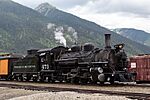 |
Steam | 2-8-2 | K-28 | American Locomotive Company (ALCO) | 1923 | Operational | This engine was changed from burning coal to burning oil. It returned to service in May 2021. |
| 476 | 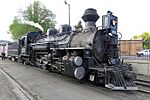 |
Steam | 2-8-2 | K-28 | American Locomotive Company (ALCO) | 1923 | Operational | This engine was on display for many years. It was restored and converted to burn oil, returning to service in May 2022. |
| 478 |  |
Steam | 2-8-2 | K-28 | American Locomotive Company (ALCO) | 1923 | Display | This engine is currently on display and waiting for a major repair and conversion to oil. |
| 480 |  |
Steam | 2-8-2 | K-36 | Baldwin Locomotive Works | 1925 | Operational | Restored in 1985 and converted to burn oil. It returned to service in May 2021. |
| 481 |  |
Steam | 2-8-2 | K-36 | Baldwin Locomotive Works | 1925 | Being Converted | This was the last coal-burning engine on the D&SNG. It is now being converted to oil. |
| 482 |  |
Steam | 2-8-2 | K-36 | Baldwin Locomotive Works | 1925 | Operational | This engine was traded from another railroad. It was restored and converted to oil, returning to service in December 2021. |
| 486 |  |
Steam | 2-8-2 | K-36 | Baldwin Locomotive Works | 1925 | Display | This engine is on display and waiting for a major repair and conversion to oil. |
| 493 | 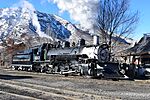 |
Steam | 2-8-2 | K-37 | Baldwin Locomotive Works Burnham Shops |
1928 | Operational | This engine was restored and converted to oil, running for the first time in January 2020. It's been a main engine since then. |
| 498 | 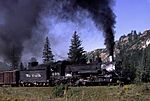 |
Steam | 2-8-2 | K-37 | Baldwin Locomotive Works Burnham Shops |
1930 | Stored | This engine is stored and used for parts to fix other locomotives. |
| 1 | 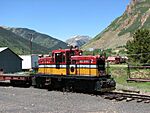 |
Diesel | (B-B) | 50-Ton (Center-Cab) | General Electric (GE) | 1957 | Operational | Nicknamed the "Hotshot", it's used for moving cars around the Durango shop. |
| 5 |  |
Diesel | (B-B) | 45-Ton (Center-Cab) | General Electric (GE) | 1960 | Stored | This engine is abandoned behind the Durango roundhouse. |
| 11 | 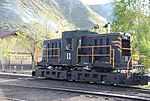 |
Diesel | (B-B) | 98-Ton (Center-Cab) | U.S. Steel General Electric (GE) |
Unknown | Operational | Nicknamed the "PB". |
| 101 |  |
Diesel | (C-C) | DL-535E | Montreal Locomotive Works | 1969 | Operational | Acquired from the White Pass and Yukon Route in 2020. |
| 103 | 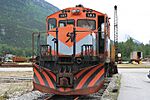 |
Diesel | (C-C) | DL-535E | Montreal Locomotive Works | 1969 | Operational | Acquired from the White Pass and Yukon Route in 2021. |
| 106 |  |
Diesel | (C-C) | DL-535E | Montreal Locomotive Works | 1969 | Operational | Acquired from the White Pass and Yukon Route in 2021. |
| 107 | 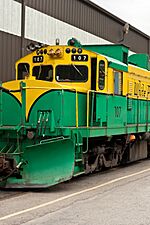 |
Diesel | (C-C) | DL-535E | Montreal Locomotive Works | 1969 | Operational | Acquired from the White Pass and Yukon Route in 2020. |
| 1201 | – | Diesel | (B-B) | MP2000NG | Motive Power and Equipment Solutions, Inc. | 2018–2020 | Stored | Acquired in response to the 416 Fire. It's stored in the Durango yard. |
| 1202 | – | Diesel | (B-B) | MP2000NG | Motive Power and Equipment Solutions, Inc. | 2018–2020 | Stored | Acquired in response to the 416 Fire. It's stored in the Durango yard. |
Steam Locomotives: How They Work
The steam locomotives used on the Durango and Silverton Narrow Gauge Railroad were built in the 1920s. There are three main types: K-28, K-36, and K-37. These names tell you about their wheel arrangement and how much power they have. As of 2023, six of the nine steam locomotives are working.
The "K" in their names stands for "Mikado," which describes a locomotive with two small wheels in front, eight big driving wheels, and two small wheels at the back. The numbers 28 and 36 tell you how much pulling force (tractive effort) the locomotives have in thousands of pounds. For example, a K-28 has 27,500 pounds of pulling force, and a K-36 has 36,200 pounds.
K-28 Locomotives (470 Series)
The K-28 locomotives were built in 1923. They were designed to carry freight. Because they are smaller, these engines are often used for shorter trains or to help push other trains.
Out of the original ten K-28s, only three are still around, and the D&SNG owns and operates all of them. The other seven were taken by the United States Army in 1942 for use during World War II and later scrapped.
Locomotives 473, 476, and 478 worked on many parts of the old D&RGW railroad. Today, 473 and 476 are operational and have been converted to burn oil. Locomotive 478 is on display at the D&SNG Museum, waiting for a major repair.
K-36 Locomotives (480 Series)
The K-36 locomotives were built in 1925 and were the last narrow-gauge locomotives built for the D&RGW. They were used for hauling freight. The "36" means they have 36,200 pounds of pulling force. These engines are known for their strong, practical look.
The D&SNG owns four K-36s: Nos. 480, 481, 482, and 486. All of them are operational or being converted. The Cumbres and Toltec Scenic Railroad owns five others. One K-36, No. 485, was unfortunately damaged in 1955 and scrapped for parts.
Locomotives 480 and 482 have been converted to oil burners and are working. Locomotive 481 is currently being converted to oil. Locomotive 486 is on display at the D&SNG Museum, waiting for a major repair and conversion to oil.
K-37 Locomotives (490 Series)
The K-37 locomotives were built in 1928 and 1930. They were made using parts from older, larger locomotives.
The D&SNG owns two K-37s: Nos. 493 and 498. Locomotive 498 is not working and is used for parts. Locomotive 493 was on display for a while but was moved for restoration in 2016. After the 2018 wildfire, the D&SNG decided to restore 493 and make it their first engine to be converted to oil. It started running again in January 2020 and has been a main engine since then.
Another K-37, No. 497, was once owned by the D&SNG but was traded to the Cumbres and Toltec Scenic Railroad in 1991.
Diesel Locomotives
Diesel engines first came to the Durango Yard in the 1960s. Today, the D&SNG uses several diesel locomotives for various tasks.
- Diesel engine #1, nicknamed the "Hotshot," is a 50-ton engine built in 1957. It's used for moving cars around the Durango shop.
- Diesel engine #5 is a 45-ton engine built in 1960. It's currently stored in Durango.
- Diesel engine #11, nicknamed the "P.B.," is a 98-ton engine.
- Diesel engines #101, #103, #106, and #107 are four engines acquired from the White Pass and Yukon Route in Alaska in 2020 and 2021. All four are now working.
- Diesel engines #1201 and #1202 are custom-built engines acquired in 2018 after the 416 Fire. They are currently stored in Durango, waiting to be put into service.
- Locomotives
- Trains
D&SNG Train Cars
The Durango and Silverton Narrow Gauge Railroad has over 50 train cars. Some of these are among the oldest passenger cars still in use today.
Concession Cars
Concession cars are where you can buy snacks and drinks on the train. Many of these cars have been rebuilt and renumbered several times over the years.
- Concession car 64 was originally a mail-baggage car from 1889.
- Concession car 126 was first a baggage car. It was converted to a snack bar car in 1963 and then to a full concession car in 1982.
- Concession car 212 was originally a coach from 1879. It was rebuilt many times and became a full concession car in 1986.
- Concession car 566 was originally a mail car from 1882. It was rebuilt and is now used as a concession car.
Passenger Coaches
The D&SNG has many passenger coaches. One special car is the combination car 213, named Bitter Root Mine. It was built in 1983 and has a special lift for passengers in wheelchairs.
Other coaches include:
- 257 Shenandoah, built in 1880.
- 291 King Mine, built in 1881.
- 311 McPhee, built in 1881.
- 319 Needleton, built in 1882.
- 323 Animas City, built in 1887.
- 327 Durango, built in 1887.
- 330 Cascade, built in 1963.
- 331 Trimble, built in 1963.
- 332 La Plata, built in 1964.
- 333 Tacoma, built in 1964.
- 334 Hermosa, built in 1964.
- 335 Elk Park, built in 1964.
- 336 Rockwood, built in 1964.
- 337 Fort Lewis, built in 1964.
- 503 Crazy Woman Creek, acquired in 2019.
- Museum exhibits
Cinco Animas B-2
Built in 1883, the Cinco Animas was first a sleeper car for immigrants. It was later changed into a business car. In 1982, it was sold to the D&SNG. It runs daily during the summer.
Nomad B-3
Built in 1878, the Nomad was originally named Fairplay. It was a favorite car of the D&RG president. It even hosted Presidents William H Taft, Ulysses S Grant, and Theodore Roosevelt! It was acquired by the D&SNG in 1982. Today, it is the oldest private railroad coach still running in the United States. It runs daily during the summer.
General Palmer B-7
The General Palmer was built in 1880 as a business car. It was restored in 2001 by the D&SNG. This car is used only by the owner, Allen Harper, his family, and guests.
San Juan 312
Built in 1887, this coach was rebuilt several times. In 2007-2008, it was rebuilt with very comfortable seating and renamed San Juan. It runs during the summer.
Alamosa 350
Built in 1880, this car was originally named Hildago. It was rebuilt many times and became a parlor-buffet car named Alamosa. In 1981, it was bought by the D&SNG and converted into a parlor car that seats twenty-five people. It runs daily during the summer.
Prospector 630
This car was built in 1984 as a coach. In 2009, it became an upscale family coach called the Prospector. It has comfortable table and chair seating. The ceiling has a large map of the train's route, so passengers can follow along.
Tall Timber Legend 631 & Tall Timber Legacy 632
These cars were built in 1985 and 1986 to help with the increase in passengers. In 2009, they were converted with very comfortable seats. They are mainly used to take passengers to Tall Timber for zip-lining adventures.
Open Observation Cars
Open observation cars let passengers enjoy the views with open sides. Many of these cars were built between 1963 and 1986. Some were made from old boxcars, and others from old stock cars.
Silver Vista 313
The original Silver Vista was built in 1947. It was a very popular car with a glass roof, making it unique. Sadly, the original was destroyed by a fire in 1953. A new Silver Vista was built in 2006 to recreate the experience. It runs daily during the summer.
- Original Silver Vista 313
Rio Grande No. 410
This car was built in 1987-1988 as a railbus trailer. It was later rebuilt into an open observation car. In 2006-2007, it was rebuilt again with comfortable, large seats for better views. It runs daily during the summer.
Cabooses
- Caboose No. 0505 was built in 1886 and is used for shelter and food. It is currently out of service.
- Caboose No. 0540 was built in 1881 and carries tools and supplies for track maintenance.
Caboose No. 0500
Caboose No. 0500 was built in 1886. It was restored to its original look and can be rented for special trips, holding up to eight people. It is on display in the museum and is out of service.
Rail Camp Car No. 3681
This car was originally a boxcar. In 1984, the D&SNG rebuilt it with a kitchen, bathroom, and beds. It's used for "elegant camping" at Cascade Canyon Wye and can hold up to eight people. It is currently out of service.
Coaches Not in Service
- Mail baggage car No. 66 was built in 1887. It was used as an office and waiting room for another railway.
- Mail baggage car No. 119 was built in 1882. It was sold to a private owner in 2020 for restoration.
- Coach No. 460 is the only narrow-gauge tourist sleeper car left from a group built in 1886. It is being preserved as it is and will not be put back into service.
Railroad Museums
The D&SNG has two museums: the D&SNG Museum and the Silverton Freight Yard Museum. Both show off historic train equipment used on the old D&RGW line.
D&SNG Museum in Durango
Opened in 1998, the D&SNG Museum celebrates railroads in southwest Colorado and across the country. It's located in the Durango roundhouse. Half of the roundhouse is for working steam engines, and the other half is for the museum. You can see old railroad items and artifacts from the Durango and Silverton areas. There's also a model train layout that looks like the D&RGW railroad. A special movie car, used in the film Butch Cassidy and the Sundance Kid, shows informational films about the railroad.
Engine No. 42 on Display
Engine 42 is on display in the D&SNG Museum. It was built in 1887 and weighs 35 tons. It was used by another railroad until 1952. After being displayed in a few different places, it was brought to Durango in 1983. It has not been restored to run again but is a great piece of history to see.
Baggage Car No. 127
This car was originally a flat car, rebuilt in 1968 as a baggage car for the movie Butch Cassidy and the Sundance Kid. It later became a concession car for the D&SNG. Now, No. 127 is used as a movie theater inside the museum.
- Museum exhibits
Silverton Freight Yard Museum
The Silverton Freight Yard Museum opened in 1999. It's located at the Silverton train station and rail yard. You can see old outfit cars (train cars used for living) and side-dumped gondolas (open cars for carrying materials). The Silverton station also has local historical items on display.
- Museum exhibits
Visiting Trains and Equipment
Narrow-gauge trains and parts are rare today. When old narrow-gauge equipment is brought back to life, there are few places where they can run. Many of these special trains visit the D&SNG railroad during its annual Railfest event in August.
D&RGW No. 315
D&RGW No. 315 is a C-18 locomotive built in 1895. It worked around Durango until 1949. To save it from being scrapped, it was put on display. From 1998 to 2007, it was restored to working condition by the Durango Railroad Historical Society. It ran for the first time in 58 years in August 2007. Since 2016, No. 315 has been operating on special trips at the Cumbres and Toltec Scenic Railroad. It was temporarily out of service for a big inspection but returned to service in March 2023.
E&P No. 4
Eureka and Palisade No. 4 is a locomotive built in 1875. It was used in many films by Warner Bros.. After being badly damaged in a fire, it was bought by Dan Markoff and restored. Dan privately owns this engine and sometimes brings it to railroads like the D&SNG to operate.
Casey Jones Railbus
The Casey Jones railbus was built in 1915 from a Model T car. It was first used as an ambulance for a mine and often carried mine officials. It can hold 11 passengers. The Casey Jones was restored and is owned by the San Juan Historical Society. It has run on the D&SNG a few times for special events.
Galloping Goose Railbuses
The Galloping Goose railcars were special vehicles made by the Rio Grande Southern Railroad during the Great Depression. They were used to carry mail and passengers. Six of the seven "Geese" still exist today, and some have visited the D&SNG. Galloping Goose No. 5 was built using parts from a 1928 Pierce-Arrow limousine and a school bus. It was restored in 1998 and is now operational.
Southern Pacific No. 18
SP No. 18 is a narrow-gauge locomotive built in 1911. It was restored from 2009 to 2017. It visited Durango from November 2018 to October 2019 to help train D&SNG staff on how to operate oil-fired steam engines. It returned to the D&SNG from April to October 2021. It has been very helpful as a "helper" engine for the long Silverton Train while the D&SNG converts its own locomotives to oil.
In Movies and Music
The train is featured in the song The Silverton by C. W. McCall.
The D&RGW and D&SNG railroads have appeared in many films:
- 1950, A Ticket to Tomahawk
- 1952, Denver and Rio Grande
- 1954, Siege at Red River
- 1955, Run for Cover
- 1956, Around the World in 80 Days
- 1957, Night Passage
- 1965, The Sons of Katie Elder
- 1966, Gunpoint
- 1969, Butch Cassidy and the Sundance Kid (the famous "cliff jump" scene was filmed near Baker's Bridge)
- 1971, Support Your Local Gunfighter
- 1988, The Tracker
- 1991, a Lexus LS400 commercial
- 2006, The Prestige
- 2022, "Long Haul" music video by musician Anthony D'Amato
More to Explore
- List of Colorado historic railroads
- List of heritage railroads in the United States
- Colorado Railroad Museum
- Cumbres and Toltec Scenic Railroad
- White Pass and Yukon Route
- Great Smoky Mountains Railroad
- Texas State Railroad




